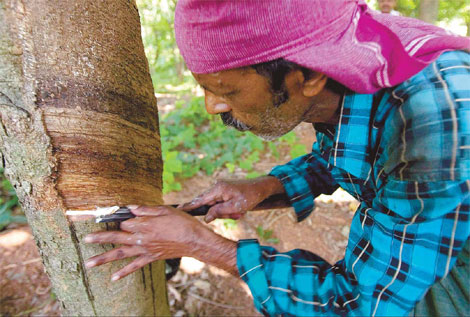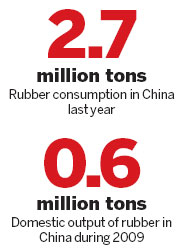Top Biz News
Drought takes bounce off rubber growers
By GUO ANFEI and LIU YIYU (China Daily)
Updated: 2010-04-01 10:30
 |
Large Medium Small |
|
 |
|
A farmer taps a rubber tree for its latex sap on a farm in Mundur, Palakkad, India. In addition to China, most other major rubber producers in Southeast Asia could face an output crunch due to unfavorable weather conditions this year. [Bloomberg News] |
XISHUANGBANNA, Yunnan: Last weekend's artificial rain has bought little cheer for Bulu and other rubber planters in Jino town of Xishuangbanna, southern Yunnan, as output continues to be severely affected by the prolonged drought in the region.
With dark despair in his face Bulu said that his 3.5-hectare rubber plantation has been ravaged by powdery mildew, a disease wherein rubber trees shed leaves and latex production slows. So much so that Bulu fears that output this year could plunge nearly 30 percent.
Xishuangbanna, the second-largest rubber growing area after Hainan province in China, has 246,000 hectares of rubber trees and the cash crop provides much of the income for local farmers.
| ||||
There are around 30 private rubber manufacturers here and most of them have ceased production, as the crop requires huge quantities of water.
"The average price of rubber has soared to 24 yuan per kg from 14.6 yuan per kg last year," said Gong Sixiao, manager of Xing Hong Rubber Factory.
With trends indicating a shortfall of rubber worldwide, prices have increased sharply in most of the international market.
Rubber advanced to its highest level on March 29 since September 2008 as supply in Thailand, the world's largest exporter, is expected to decline.
Futures in Tokyo rose as high as 312.3 yen per kg ($3,373 a metric ton). The price has advanced nearly 13 percent this year.
But with drought playing havoc in the growing regions, China, the largest natural rubber importer, will have no other choice but to import the commodity from abroad, say analysts.
China's imports of natural rubber surged 63 percent in the first two months of this year, according to Bloomberg data.
China consumed 2.7 million tons of rubber last year, while domestic output was 0.6 million tons.

Most of the other major rubber producers in Southeast Asia could also face an output crunch due to unfavorable weather conditions.
Output in Indonesia, the second-largest rubber producer, may drop to 2 million tons this year from 2.4 million in 2009 if unfavorable weather persists, the Rubber Association of Indonesia said.
India's biggest growing area is also facing a drought-like situation. The world's fourth-largest producer expects output to drop 4 percent this year.
Against such a backdrop, it looks highly unlikely that supplies will grow.
The target of 6 percent growth in global supplies for this year may not be met due to the drought in major producing nations, the Association of Natural Rubber Producing Countries said.
Expansion in output would be limited by "the severity of drought" in major producing countries, the association said.
"April and May are traditionally the best months to tap latex. But with rains not expected till the latter half of May, rubber trees would need water to sustain themselves," said Guo Shunyun, director of the cash crops department at the bureau of agriculture in Xishuangbanna.
Guo said these factors will lead to a 30 percent reduction in rubber output from the region.













